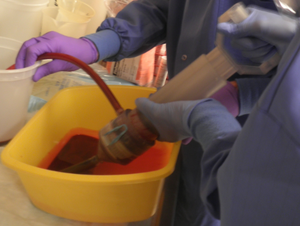
Problem being addressed
Ruptured ectopic pregnancy is a leading cause of maternal mortality worldwide and women who suffer are often in need of blood transfusions as they lose considerable amounts of blood. Autologous blood transfusion is an important technique used in resource-poor settings where there are often shortages of donated blood. This method essentially involves physically extracting patients’ blood and re-infusing it back into their bodies through a gauze filter. However, this “soup ladle” model is slow, lacks in sterility and filtering efficacy, is labor-intensive, and potentially dangerous for patients, often resulting in complications related to acute anemia.
Detailed description of the solution
Hemafuse is a simple and affordable handheld mechanical device that allows physicians to manually suction blood from women’s abdomens, quickly filter out blood clots and impurities, and re-tranfuse it using a standard blood bag. It is a closed, sterile unit, and thus is optimal for handling blood. It also only requires one clinician to operate it rather than 3 or 4 who are required for the conventional autotransfusion method. Hemafuse is made from durable, reusable, and disposable materials that can be sterilized in between patients.
Designed by
- Designed by: Hemafuse was invented by students of the University of Michigan Specialization in Global Health Design program in Ann Arbor, MI.
- Manufacturer/Location: This device is now being developed under the social venture offshoot of the program, Design Innovations for Infants and Mothers Everywhere (DIIME).
When and where it was tested/implemented
Testing of Hemafuse began in 2011 in Kumasi, Ghana and now is being tested in several in 3-5 tertiary hospitals. The initial target market is Ghana and other sub-Saharan African countries, however, the device will eventually be introduced in Haiti and Cambodia as well.
Funding Source
- People’s Choice Award at Accelerate Michigan student competition.
- ASME IShow Competition
- Company is also looking for impact investors.
- TechArb
References
Other internally generated reports
Hemafuse. (n.d.). DIIME. Retrieved November 15, 2012 from here.
Hemafuse autologous blood transfusion device. (2011, November 3). Ashoka Changemakers.Retrieved November 16, 2012 from here.
Externally generated reports
Hemafuse. (n.d.). Dell Social Innovation Challenge. Retrieved November 16, 2012 from link.
Hemfause for Blood Salvage by DIIME. (2012, October 15). Maternova: Tools and Ideas that Save Mothers and Newborns. Retrieved November 16, 2012 from here.
Shek, A. (2012, May 12). Healthcare Startup Seeks to Benefit Developing Nations. Benzinga. Retrieved November 16, 2012 from here
What my startup did last semester: TechArb Showcase. (2012, April 10). Michigan Engineering. Retrieved November 16, 2012 from here.